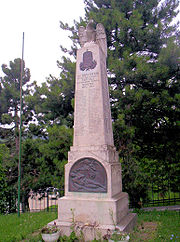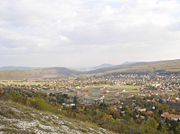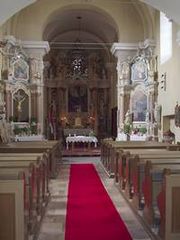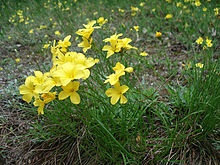- Nagykovácsi
-
Nagykovácsi Location of Nagykovácsi Coordinates: 47°35′N 18°53′E / 47.58°N 18.88°ECoordinates: 47°35′N 18°53′E / 47.58°N 18.88°E Country  Hungary
HungaryCounty Pest Area – Total 14.14 km2 (5.5 sq mi) Population – Total 6,128 Time zone CET (UTC+1) – Summer (DST) CEST (UTC+2) Postal code 2094 Area code(s) 26 Website http://www.nagykovacsi.hu/  World War II memorial monument
World War II memorial monument
Nagykovácsi (whose name in English translates as "Great Smithy") is a small town in the Pilisvörösvári kistérség district of Hungary situated some 15 km (9 mi) north-east of the centre of Budapest, in a valley, at an altitude of 340 metres. It is located next to the second district of Budapest. In December 2007 its population was given as 6,128 by the town council (Nagykovácsi Nagyközség Önkormányzat), though this figure does not include the many people who own a property there as a second residence. The town is known for the natural beauty of its surrounding hills and forests and many parts of the nearby forest have been designated conservation areas—Budai Tájvédelmi Körzet (the "Buda Land Protection Area")—in order to protect several rare species of flora growing there.
From archaeological finds it is known that this region has been inhabited since time immemorial. Objects found in the caves of the Remete ravine and along the banks of Ördög indicate that people lived here during the Ice, Iron, and Stone ages. Various tools, coins and fragments of stone statues unearthed in the area show that there were inhabitants, too, under the Roman Empire. Of these stone fragments, the most interesting were embedded in the wall of the local church when it was built.
In medieval records, Nagykovácsi is referred to as Koachi and Kowachy. These names indicate that royal smiths viz. ironsmiths (kovács), lived in the town.
The first local document still in existence, a deed of gift, dates from 1254. During the Turkish occupation in Hungary, in the middle of the 16th Century, the village suffered much destruction and the population fell sharply. Once the Turks had been driven out, the Habsburg family who reigned in Hungary invited Swabian colonists to settle in Kovácsi (1700-1760). These newcomers were skilful stockbreeders and farmers and also built three quarries, a coal-mine and two lime kilns.
The manor in Nagykovácsi was built in first half of the 19th Century by the local Teleki family. Thereafter the property passed into the hands of the Tisza family and today it is known still as the Tisza Manor. Originally the children of Hungarian foresters received regular school teaching in this well-preserved building. The idea of gathering such children into an educational establishment was gradually recognized throughout Europe as an excellent initiative and attracted interested visitors from many countries. At the end of the Second World War, the manor was confiscated and, since 1958, it has served as an agricultural college. Many of the German-speaking population were forcibly resettled after the Second World War and new inhabitants arrived from the Hungarian Great Plains (Alföld), the parts of Upper Hungary (Felvidék) (today in Slovakia), and from Budapest to take their place.
Today local townspeople make every effort to protect local sights, amongst these the statue of the Virgin Mary in the Church and a memorial to the fallen of both world wars.
Items of Local Interest
- The American school of Budapest is situated in Nagykovácsi.
One of the rarest plants in the world, the Dolomite flax (Linum dolomiticum), an ancient breed of shrub, is preserved on a strictly protected 10-acre (40,000 m2) plot in the hills between Nagykovácsi and the neighbouring village of Pilisszentiván. It is the only known locale for this plant.[1]
References
External links
- The American International School of Budapest
- vendégváró.hu (Hungarian)
- Nagykovacsi.hu (Hungarian)
- Sztaki.hu (Hungarian)
- Nagykovácsi.net (Hungarian)
Categories:- Populated places in Pest County
Wikimedia Foundation. 2010.






